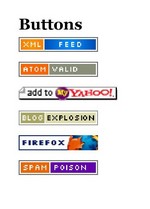RSS grows beyond blogs
 This article describes numerous uses for RSS that go beyond the ubiquitous blog. It’s an interesting read, especially because it confines itself to implemented uses, rather than the hundreds of uses we can envision. On a related note I noticed this quote in an article by CRN:
This article describes numerous uses for RSS that go beyond the ubiquitous blog. It’s an interesting read, especially because it confines itself to implemented uses, rather than the hundreds of uses we can envision. On a related note I noticed this quote in an article by CRN:
Microsoft partisans imagine a day when business users get realtime pings on their Office desktop software whenever their ERP systems detect inventories below a certain level. Beneath the covers, that simple-looking alert will rely on a confluence of technologies, including Office desktop applications, Microsoft’s planned “Maestro” realtime reporting server and a back-end SharePoint Portal/Excel Server combination.
Decidedly “RSS like” capability although probably not using RSS as the format. The same article goes on to describe some of the conditional alerting that would be enabled by Excel Server:
“You’d set up an Excel model on the desktop, export it to the server, bind it to a [database] or, via Maestro, to an application source,” he said. “The model runs constantly on the server, feeding updated dashboard data via new Office 12 tools or a [business intelligence] tool. Or [it can] send you an e-mail or an instant-messaging or a VoIP call.” Microsoft, …



 I have thought for a long time that
I have thought for a long time that 
 I only work part-time and have been struggling to find a way to manage my time, it’s been a long process and has so fair failed to control overload.
I only work part-time and have been struggling to find a way to manage my time, it’s been a long process and has so fair failed to control overload.
 I am working on refreshing a great guide that my companies research team produced on this topic a few years ago. I have some interesting material, and recently came across
I am working on refreshing a great guide that my companies research team produced on this topic a few years ago. I have some interesting material, and recently came across 
 In
In 
 Of course some people do get a lot of email and need to read a lot of blogs, but it’s also a great place to hide away from doing what you really need to be doing. I have noticed the following types of avoidance behaviour (the example below are not always avoidance behaviour of course):
Of course some people do get a lot of email and need to read a lot of blogs, but it’s also a great place to hide away from doing what you really need to be doing. I have noticed the following types of avoidance behaviour (the example below are not always avoidance behaviour of course):
 I am being overloaded by information on “information overload”, just today one of my friends
I am being overloaded by information on “information overload”, just today one of my friends